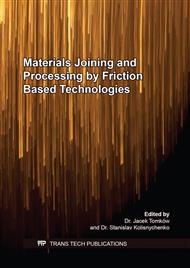p.87
p.93
p.99
p.105
p.110
p.117
p.122
p.128
p.133
Mechanical Characterization of Aluminium Alloy 6061 Powder Deposit Made by Friction Stir Based Additive Manufacturing
Abstract:
Additive Friction Stir (AFS) has the potential for extensive future application in metal based additive manufacturing. Powder based AFS is specifically useful for fabricating functionally graded structures. But, the consolidation of powder inside the hollow tool used in this operation hinders the powder based AFS process. This problem could be resolved by Additive Friction Stir Processing (AFSP) while maintaining the key advantages of AFS. A 3D deposit structure of height 5 mm and width 64 mm was made from Al6061 alloy powder by AFSP. Mechanical properties like ultimate tensile strength, yield strength and micro-hardness of the deposit were evaluated in both longitudinal and transverse directions. The ultimate tensile strength and micro-hardness of the deposit were comparable to Al6061-O and there was a significant increment in tensile yield strength. Also, the isotropic nature of the deposit could be inferred from similar mechanical properties in the longitudinal and transverse direction. Dimple ruptures seen in fractographic analysis gave evidence to the ductile nature of the deposit.
Info:
Periodical:
Pages:
110-116
Citation:
Online since:
June 2020
Authors:
Price:
Сopyright:
© 2020 Trans Tech Publications Ltd. All Rights Reserved
Share:
Citation:



